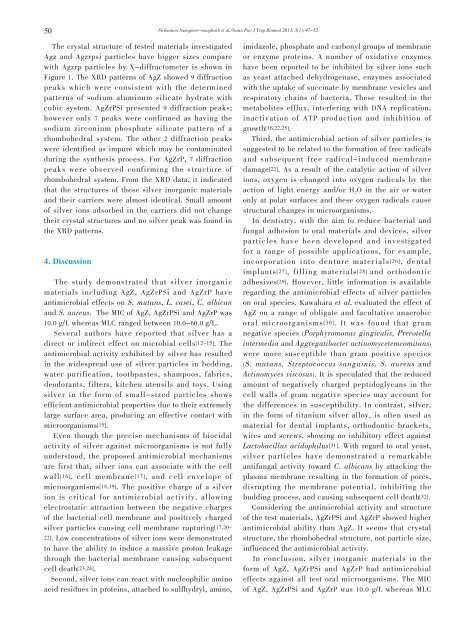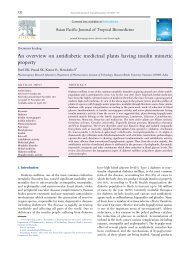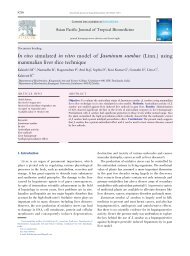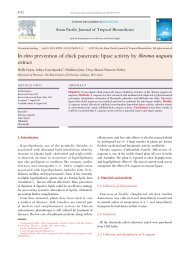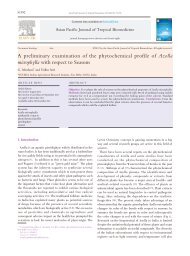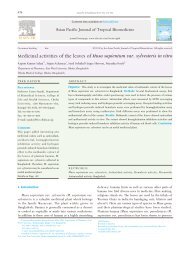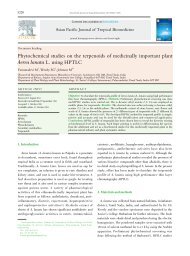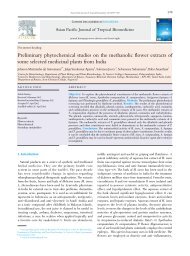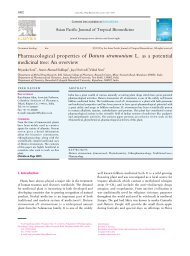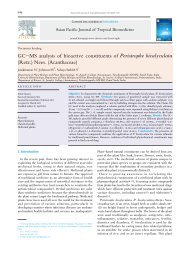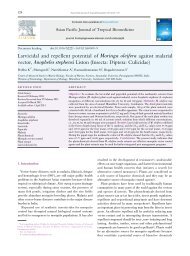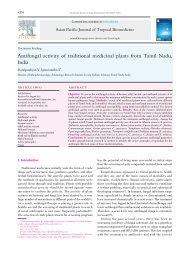Antimicrobial effects of silver zeolite, silver zirconium phosphate ...
Antimicrobial effects of silver zeolite, silver zirconium phosphate ...
Antimicrobial effects of silver zeolite, silver zirconium phosphate ...
Create successful ePaper yourself
Turn your PDF publications into a flip-book with our unique Google optimized e-Paper software.
50<br />
Sirikamon Saengmee-anupharb et al./Asian Pac J Trop Biomed 2013; 3(1): 47-52<br />
The crystal structure <strong>of</strong> tested materials investigated<br />
Agz and Agzrpsi particles have bigger sizes compare<br />
with Agzrp particles by X-diffractometer is shown in<br />
Figure 1. The XRD patterns <strong>of</strong> AgZ showed 9 diffraction<br />
peaks which were consistent with the determined<br />
patterns <strong>of</strong> sodium aluminum silicate hydrate with<br />
cubic system. AgZrPSi presented 9 diffraction peaks;<br />
however only 7 peaks were confirmed as having the<br />
sodium <strong>zirconium</strong> <strong>phosphate</strong> silicate pattern <strong>of</strong> a<br />
rhombohedral system. The other 2 diffraction peaks<br />
were identified as impure which may be contaminated<br />
during the synthesis process. For AgZrP, 7 diffraction<br />
peaks were observed confirming the structure <strong>of</strong><br />
rhombohedral system. From the XRD data, it indicated<br />
that the structures <strong>of</strong> these <strong>silver</strong> inorganic materials<br />
and their carriers were almost identical. Small amount<br />
<strong>of</strong> <strong>silver</strong> ions adsorbed in the carriers did not change<br />
their crystal structures and no <strong>silver</strong> peak was found in<br />
the XRD patterns.<br />
4. Discussion<br />
The study demonstrated that <strong>silver</strong> inorganic<br />
materials including AgZ, AgZrPSi and AgZrP have<br />
antimicrobial <strong>effects</strong> on S. mutans, L. casei, C. albican<br />
and S. aureus. The MIC <strong>of</strong> AgZ, AgZrPSi and AgZrP was<br />
10.0 g/L whereas MLC ranged between 10.0-60.0 g/L.<br />
Several authors have reported that <strong>silver</strong> has a<br />
direct or indirect effect on microbial cells[12-15]. The<br />
antimicrobial activity exhibited by <strong>silver</strong> has resulted<br />
in the widespread use <strong>of</strong> <strong>silver</strong> particles in bedding,<br />
water purification, toothpastes, shampoos, fabrics,<br />
deodorants, filters, kitchen utensils and toys. Using<br />
<strong>silver</strong> in the form <strong>of</strong> small-sized particles shows<br />
efficient antimicrobial properties due to their extremely<br />
large surface area, producing an effective contact with<br />
microorganisms[15].<br />
Even though the precise mechanisms <strong>of</strong> biocidal<br />
activity <strong>of</strong> <strong>silver</strong> against microorganisms is not fully<br />
understood, the proposed antimicrobial mechanisms<br />
are first that, <strong>silver</strong> ions can associate with the cell<br />
wall [16], cell membrane[17], and cell envelope <strong>of</strong><br />
microorganisms[18,19]. The positive charge <strong>of</strong> a <strong>silver</strong><br />
ion is critical for antimicrobial activity, allowing<br />
electrostatic attraction between the negative charges<br />
<strong>of</strong> the bacterial cell membrane and positively charged<br />
<strong>silver</strong> particles causing cell membrane rupturing[17,20-<br />
22]. Low concentrations <strong>of</strong> <strong>silver</strong> ions were demonstrated<br />
to have the ability to induce a massive proton leakage<br />
through the bacterial membrane causing subsequent<br />
cell death[23,24].<br />
Second, <strong>silver</strong> ions can react with nucleophilic amino<br />
acid residues in proteins, attached to sulfhydryl, amino,<br />
imidazole, <strong>phosphate</strong> and carbonyl groups <strong>of</strong> membrane<br />
or enzyme proteins. A number <strong>of</strong> oxidative enzymes<br />
have been reported to be inhibited by <strong>silver</strong> ions such<br />
as yeast attached dehydrogenase, enzymes associated<br />
with the uptake <strong>of</strong> succinate by membrane vesicles and<br />
respiratory chains <strong>of</strong> bacteria. These resulted in the<br />
metabolites efflux, interfering with DNA replication,<br />
inactivation <strong>of</strong> ATP production and inhibition <strong>of</strong><br />
growth[16,22,25].<br />
Third, the antimicrobial action <strong>of</strong> <strong>silver</strong> particles is<br />
suggested to be related to the formation <strong>of</strong> free radicals<br />
and subsequent free radical-induced membrane<br />
damage[22]. As a result <strong>of</strong> the catalytic action <strong>of</strong> <strong>silver</strong><br />
ions, oxygen is changed into oxygen radicals by the<br />
action <strong>of</strong> light energy and/or H 2 O in the air or water<br />
only at polar surfaces and these oxygen radicals cause<br />
structural changes in microorganisms.<br />
In dentistry, with the aim to reduce bacterial and<br />
fungal adhesion to oral materials and devices, <strong>silver</strong><br />
particles have been developed and investigated<br />
for a range <strong>of</strong> possible applications, for example,<br />
incorporation into denture materials[26], dental<br />
implants[27], filling materials[28] and orthodontic<br />
adhesives[29]. However, little information is available<br />
regarding the antimicrobial <strong>effects</strong> <strong>of</strong> <strong>silver</strong> particles<br />
on oral species. Kawahara et al. evaluated the effect <strong>of</strong><br />
AgZ on a range <strong>of</strong> obligate and facultative anaerobic<br />
oral microorganisms [30]. It was found that gram<br />
negative species (Porphyromonas gingivalis, Prevotella<br />
intermedia and Aggregatibacter actinomycetemcomitans)<br />
were more susceptible than gram positive species<br />
(S. mutans, Streptococcus sanguinis, S. aureus and<br />
Actinomyces viscosus). It is speculated that the reduced<br />
amount <strong>of</strong> negatively charged peptidoglycans in the<br />
cell walls <strong>of</strong> gram negative species may account for<br />
the differences in susceptibility. In contrast, <strong>silver</strong>,<br />
in the form <strong>of</strong> titanium <strong>silver</strong> alloy, is <strong>of</strong>ten used as<br />
material for dental implants, orthodontic brackets,<br />
wires and screws, showing no inhibitory effect against<br />
Lactobacillus acidophilus[31]. With regard to oral yeast,<br />
<strong>silver</strong> particles have demonstrated a remarkable<br />
antifungal activity toward C. albicans by attacking the<br />
plasma membrane resulting in the formation <strong>of</strong> pores,<br />
disrupting the membrane potential, inhibiting the<br />
budding process, and causing subsequent cell death[32].<br />
Considering the antimicrobial activity and structure<br />
<strong>of</strong> the test materials, AgZrPSi and AgZrP showed higher<br />
antimicrobial ability than AgZ. It seems that crystal<br />
structure, the rhombohedral structure, not particle size,<br />
influenced the antimicrobial activity.<br />
In conclusion, <strong>silver</strong> inorganic materials in the<br />
form <strong>of</strong> AgZ, AgZrPSi and AgZrP had antimicrobial<br />
<strong>effects</strong> against all test oral microorganisms. The MIC<br />
<strong>of</strong> AgZ, AgZrPSi and AgZrP was 10.0 g/L whereas MLC


